By Jeffrey B. Morris
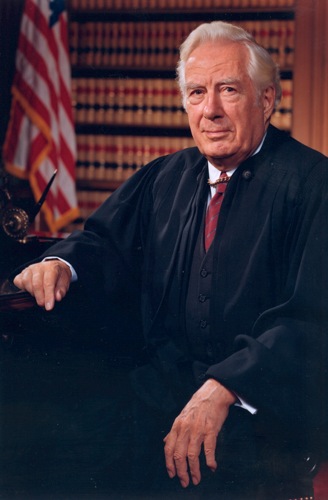 Warren Burger was appointed Chief Justice during a tumultuous time. 1968, a year of assassinations and riots had just passed. In May 1969, almost all American institutions were under attack, casualties of the Vietnam War and a decade of racial tension. Lyndon Johnson, elected in a landslide in 1964, has been too unpopular to stand for reelection. His successor, Richard Nixon, proved to be among the most controversial American political figures of the Twentieth Century. Earl Warren, Burger’s predecessor, had been among the most controversial Chief Justices in history as a result of decisions attempting to bring about racial equality and giving expansive readings to the Bill of Rights. The man Johnson had chosen to replace Warren, his close friend and advisor, Abe Fortas, not only was unable to win confirmation, but days before Burger was appointed, resigned from the Supreme Court bench under an ethical cloud.
Warren Burger was appointed Chief Justice during a tumultuous time. 1968, a year of assassinations and riots had just passed. In May 1969, almost all American institutions were under attack, casualties of the Vietnam War and a decade of racial tension. Lyndon Johnson, elected in a landslide in 1964, has been too unpopular to stand for reelection. His successor, Richard Nixon, proved to be among the most controversial American political figures of the Twentieth Century. Earl Warren, Burger’s predecessor, had been among the most controversial Chief Justices in history as a result of decisions attempting to bring about racial equality and giving expansive readings to the Bill of Rights. The man Johnson had chosen to replace Warren, his close friend and advisor, Abe Fortas, not only was unable to win confirmation, but days before Burger was appointed, resigned from the Supreme Court bench under an ethical cloud.
Burger’s Appointment
Earl Warren announced his resignation in the summer of 1968. After Fortas failed to be confirmed because of a successful filibuster by Senate Republicans and Southern Democrats, President Johnson refused – some thought petulantly – to nominate anyone else, so the vacancy awaited filling by President Nixon, who asked Warren to remain as Chief Justice until the end of the Court’s term.
Several leading possibilities had taken themselves out of the running – former New York Governor and Presidential candidate Thomas E. Dewey, Eisenhower’s Attorney General, Herbert Brownell, and Justice Potter Stewart. After Fortas’s resignation, Nixon believed it important that he not choose a close personal friend. That eliminated Secretary of State William Rogers and his old friend, Charles Rhyne.
President Nixon was more keenly aware than most Presidents have been of the importance of nominating a Chief Justice and was more careful and more personally involved than many of his predecessors. Nixon appears to have given particular weight to such factors as age, legal qualifications and integrity.
During the Presidential campaign, Nixon had sharply attacked Warren Court decisions that had “gone too far in weakening the peace forces against the criminal forces in the country,” so it can be assumed that he placed a high priority upon finding someone with similar views on constitutional criminal procedure. Nixon also spoke about his desire to select a “strict constructionist,” although it never has been quite clear what he meant by the term – a less activist jurist than Earl Warren (who would not have been difficult to find); possibly someone who would go slower on civil rights or someone who believed in judicial restraint along of the lines of former Justice Felix Frankfurter, a judge with a modest view of judicial power.
RELEASE: Warren Burger Court Turns 50
Warren E. Burger
Warren Burger was just about the right age for a Chief Justice – sixty-one. He was acquainted with Nixon, although not a personal friend. Burger had been a member of what arguably was the nation’s “second most important court,” the U.S. Court of Appeals for the District of Columbia Circuit, and, thus, had a judicial track record. What he was primarily known for in the legal community was his public opposition to many of the liberalizations of criminal procedure created by Supreme Court decisions and by the liberal wing of his own court. His nomination would prove to be quite popular with Southerners and conservatives and he was not an easy target for Northern liberals to oppose. There were no ethical blemishes in his background.
Burger did not bring to the Chief Justiceship the varied experiences in high office of a Salmon P. Chase (Senator, Governor and Secretary of the Treasury), William Howard Taft (Solicitor General, Circuit Judge, Governor-General of the Philippines, Secretary of War, President of the United States) or Charles Evans Hughes (Governor, Associate Justice, Secretary of State). However, he had been an Assistant Attorney General for three years and a judge of an important court for thirteen.
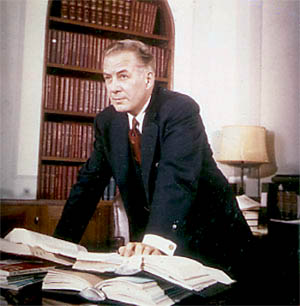 Born in St. Paul in 1907, Burger could be described as a self-made man. Although an industrious and able student, Burger had been unable to afford a prestigious education. Instead, he had graduated magna cum laude from the St. Paul College of Law (which later would become the William Mitchell Law School). Hired by a leading St. Paul law firm, Boyesen, Otis & Faricy, Burger became a partner in five years.
Born in St. Paul in 1907, Burger could be described as a self-made man. Although an industrious and able student, Burger had been unable to afford a prestigious education. Instead, he had graduated magna cum laude from the St. Paul College of Law (which later would become the William Mitchell Law School). Hired by a leading St. Paul law firm, Boyesen, Otis & Faricy, Burger became a partner in five years.
As a young attorney, Burger became involved in civic and political matters, becoming an influential supporter of the political career of Minnesota Governor, Harold Stassen. After Dwight Eisenhower was elected President, Attorney General Brownell appointed him Assistant Attorney General for the Civil Division. In 1955, Burger accepted appointment to the D.C. Circuit in large part because Washington D.C.’s climate was better for his wife than Minnesota’s.
Burger joined a talented and divided court. During his tenure, the U.S. Court of Appeals for the District of Columbia Circuit had by far the richest jurisdiction of any American appellate court except for the U.S. Supreme Court. The Court of Appeals not only had the jurisdiction of a Court of Appeals, it also served until 1971 as the equivalent of a state supreme court for the District of Columbia and handled by far the largest share of appeals from independent regulatory commissions (other than the NLRB), as well as from many important appeals from lawsuits for relief against federal officials brought in the U.S. District Court for the District of Columbia.
While Burger was a member of the D.C. Circuit, it was virtually split (especially in criminal and mental health cases) evenly between a number of strong civil libertarians and a group of judicial conservatives for whom Burger became the leading spokesmen. On the Court of Appeals, Burger was, on the whole, a moderate conservative who tended to uphold the position of the government agency in administrative law cases, to uphold the government in most loyalty-security cases, but who fiercely dissented from the jurisprudence of the opposite wing of the court in cases involving criminal law and mental health. Burger strongly supported leeway for police, prosecution and trial judges and emphasized factual guilt over procedural correctness. Conflict, primarily over criminal cases, led to a profound rift among the judges of the Court of Appeals, which raged in opinions, speeches, Congressional testimony and law review articles at a time when rising crime in the capital was receiving national attention. Inside the court, the battles over jurisprudence were quite personal. Outside the court, by the mid-1960s, Burger was known among federal judges and others concerned with the criminal law as an unusually sharp critic of Supreme Court decisions for a judge of an “inferior court.”
Burger’s national visibility was raised by a speech he gave at Ripon College in May 1967, which would later be excerpted in U.S. News & World Report, where it would be read by millions including Richard Nixon. In that speech, Burger stated that the basic function of government was to protect homes, property and lives, that “if a government failed” in this basic duty, is would not be redeemed by “providing even the most perfect system for the protection of the rights of defendants.”[i]
Expectations at the Time of Burger’s Appointment
The Chief Justice of the United States has several major responsibilities. First of all, he is a judge, responsible for bearing his share of the jurisprudence of the Court. Second, he is at least the titular head of the Court, presiding over oral argument, chairing the Court’s conference and assigning opinions when in the majority. The Chief Justice represents the Court to the nation and is expected to lead, especially when the Court is under fire. However, since the time of John Marshall, there has been the expectation that the Chief will have an outsized role in convincing his colleagues of his views on the Court’s jurisprudence. Third, statutes and custom give the Chief Justice headship of the federal courts. He is the chairman of the Judicial Conference of the United States and Chairman of the Board of the Federal Judicial Center. By statute he assigns judges to specialized courts (such as the Foreign Intelligence Surveillance Court) and to tripartite and other commissions. The Chief Justice must sign off on hundreds of assignments and designations of judges for temporary service on courts outside their Circuit. The Chief Justice also has the symbolic role as “personification” of justice at Presidential inaugurations when he administers the oath of office and when he presides over the trial of an impeached President.
Apart from the expectation that Burger would be a tough “law and order” judge, expectations as to how he might perform as Chief Justice were generally based more upon what was believed to be Richard Nixon’s intentions than upon Burger’s record. Some speculated that Nixon’s emphasis upon appointing a “strict constructionist” was his way of sending a message that he had selected a Chief Justice who would attempt to lead the Court to reverse direction sharply, not only in the criminal area, but also in such other areas of Warren Court jurisprudence as racial civil rights. Others thought that Burger would seek merely to consolidate Warren Court jurisprudence. Generally, most observers thought that Burger would attempt to lead his court and that he was well equipped for that leadership.[ii] Little noticed at the time of his appointment was Burger’s interest in judicial administration, nor the fact that much of Burger’s notable jurisprudence on the D.C. Circuit had occurred in dissent and that there he had been more the doughty warrior than the harmonizing leader.[iii]
As Chief Justice, Warren Burger contributed his share of opinions, but attempted with limited success to influence his colleagues on jurisprudential matters. He was a very active leader of the federal judiciary and, as “personification of justice,” performed his role, as many said, “looking like a Chief Justice”.
Burger Court Jurisprudence
Although it is done here, naming the work of the Supreme Court for a period co-extensive with the time a Chief Justice serves can be deceptive. The Chief Justice has eight colleagues, each with strong views of his or her own. The only weapons he has in influencing his colleagues are his vote, the power to assign opinions and the prestige of his office. The label is used here for convenience, not to suggest that Warren Burger was the dominant leader of his court on jurisprudential matters. For purposes of this essay, the label is applied for the period from December 1971, when Richard Nixon made his third and fourth appointments to the Court, until Burger’s retirement in 1986. After 1971, the Court had only two changes of personnel.[1] Four of the justices arguably composed the middle of the Court (Justices White, Powell, Stevens and Stewart/O’Connor), while Burger’s more conservative philosophy placed him on one side of the justices closer to Justice Rehnquist. At the other end of the Court were the most “liberal” Justices, Brennan and Marshall, joined increasingly by Justice Blackmun. The middle justices “controlled” the Court, although they did not always agree with each other.
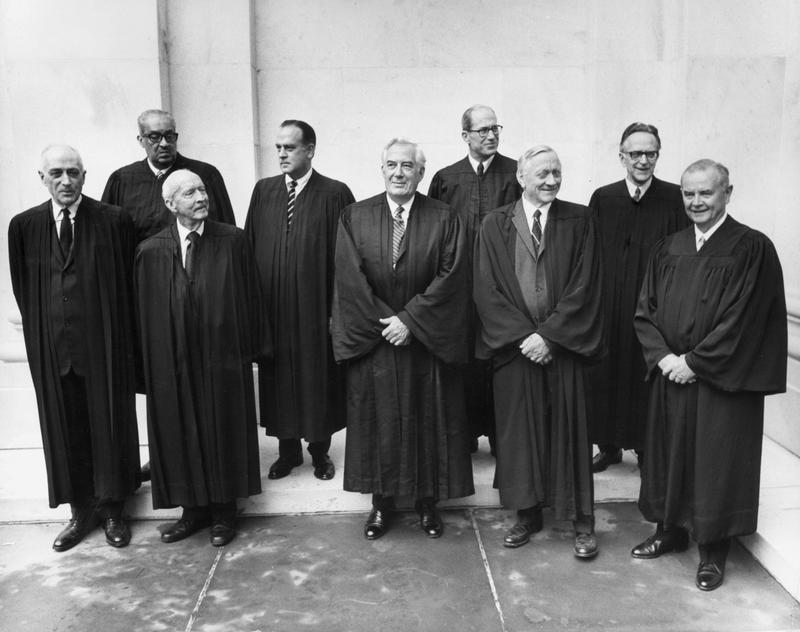 The Burger Court was, on the whole, a pragmatic, flexible court, no more likely that its predecessor to be overly restrained by precedent. It was a fractured court often able to agree on a result, but not on a single rationale. Statements of individual views proliferated. The Burger Court was also more likely to issue narrow, incremental opinions resting on the facts of a case, although from time to time it was given to bold wielding of judicial power.
The Burger Court was, on the whole, a pragmatic, flexible court, no more likely that its predecessor to be overly restrained by precedent. It was a fractured court often able to agree on a result, but not on a single rationale. Statements of individual views proliferated. The Burger Court was also more likely to issue narrow, incremental opinions resting on the facts of a case, although from time to time it was given to bold wielding of judicial power.
In contrast to the Warren Court, the Burger Court made it more difficult for litigants to use the federal courts. Burger Court decisions discouraged federal taxpayer or citizens suits attempting to hold actions of the federal government unconstitutional;[iv] denied standing where the claimant had not claimed injury[v] and where a court could not be able to order a remedy to eliminate the injury.[vi] Class actions were also discouraged.[vii]
Generally, the Burger Court was less willing than its predecessor to open new fields of constitutional litigation. In San Antonio Independent School District v Rodriguez[viii], it discouraged suits on constitutional grounds challenging methods of public school financing, while also holding that poverty was not a suspect classification.[2] In Plyler v. Doe[ix], the Court struck down a law that excluded illegal alien children from enrollment in public schools, but did not open the door to further litigation by holding that there was no constitutional right to education nor were undocumented aliens a suspect class. In City of Cleburne v. Cleburne Living Center[x], the Court invalidated a zoning ordinance that prevented the operation of a home for the mentally disabled while not recognizing them as a new suspect class.
The Burger Court was less likely than its predecessor to encroach on the traditional roles of state courts, limiting federal judges from enjoining enforcement of state laws prior to their being tested in state courts[xi] and discouraging the review of state criminal convictions in federal courts via the writ of habeas corpus.[xii] Tensions between state and federal courts bred by Warren Court decisions also ebbed because of creation of federal-state judicial councils in the states (discussed later).
In one major area, criminal law, the Burger Court sharply changed direction. The Burger Court generally tended to uphold the warrantless searches which came before them and, in 1984, severely limited the exclusionary rule of evidence by adding an exception for evidence seized in good faith by the police.[xiii] While the Burger Court did not overturn the decision of Miranda v. Arizona[xiv], which held that confessions from criminal defendants would be admissible as evidence only if certain warnings were administered prior to interrogation, the Court considerably narrowed its reach.[xv] On the other hand, in an opinion written by the Chief Justice, the Court expanded that quintessential Warren Court decision, Gideon v. Wainwright,[xvi] by holding that the right to counsel encompassed petty offenses.[xvii]
For the most part, though, the Burger Court generally consolidated major Warren Court jurisprudence involving racial civil rights. Where cases involved desegregation, the Burger Court did not pull back, but neither did it move forward boldly. On the one hand, it sanctioned a variety of possible remedies to achieve desegregation in the South[xviii] and handled the first case involving de jure school segregation in the North and West.[xix] The Burger Court upheld desegregation orders when there was evidence of intentional governmental segregation, but would go no further. In the absence of proof that there was inter-district segregation, for example, it held busing city students to suburban school systems unconstitutional.[xx]
In the first affirmative action case to be handled on the merits by the Supreme Court, the Court, in a decision where Burger was in partial dissent, struck down a race conscious remedy in a case involving a university medical school, Regents of University of California v. Bakke[xxi] but held that such remedies could be constitutional, if they survived strict scrutiny. While the Court upheld several affirmative action plans after the Bakke decision, towards the end of the Chief Justice’s tenure, it was laying the ground work for holding them unconstitutional.
There were, however, areas where the Burger Court exceeded the rights consciousness of the Warren Court. The most obvious one is gender discrimination, where the Supreme Court applied concepts of Equal Protection developed during the Warren era. The first opinion to hold that a law which discriminated according to gender was unconstitutional was written by Burger in 1971.[xxii] While gender would not be made a suspect class, overt sex classification was invalidated in a variety of contexts. In 1973 the Court struck down a federal statute that, for the purpose of computing allowances and fringe benefits, required female members of the armed forces (but not male members) to prove that they contributed more than 50% of their dependent husband’s support.[xxiii] Three years later, the Court held that to uphold a statute classifying by gender, the law “must serve important governmental objectives and must be substantially related to those objectives.”[xxiv] While the Court did not hold in every case before it that there was gender discrimination, it did so much of the time.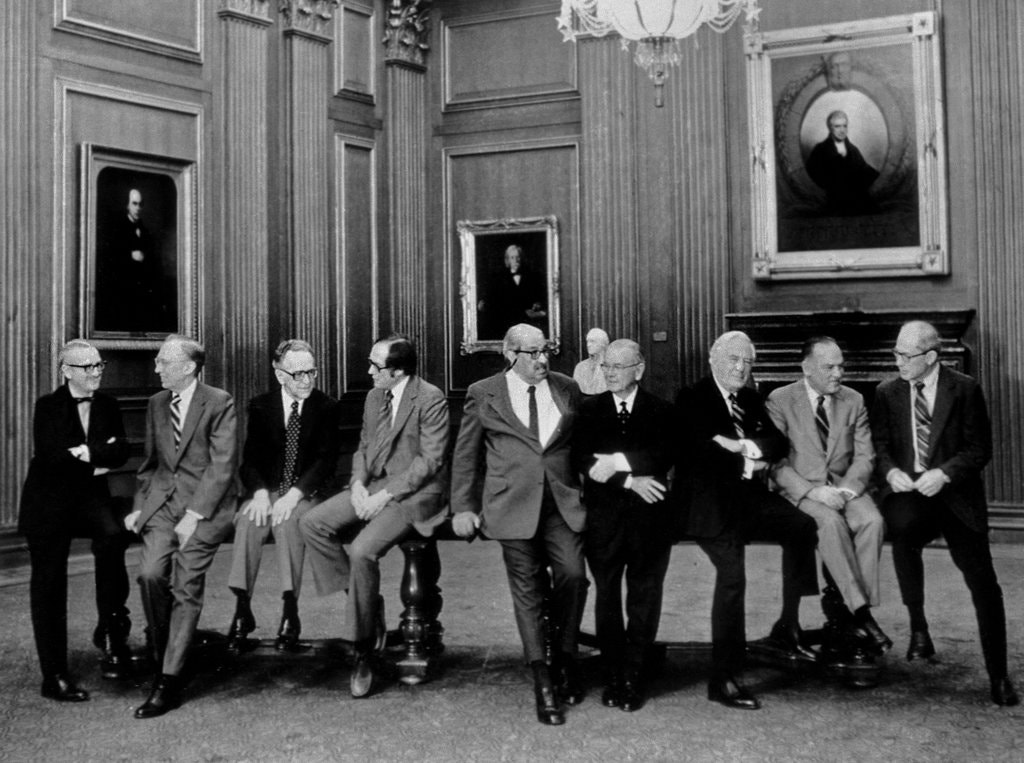
In other cases involving the Equal Protection Clause, the Court often found for the rights claimant, although the Chief Justice was not always in the majority. Narrow constitutional and statutory grounds were found to protect the rights of aliens, welfare recipients, and illegitimate children.
The most significant cases where the Burger Court broke new ground involved abortion. The most dramatic example was Roe v. Wade.[xxv] Generally, the Court continued to adhere to Roe v. Wade for the rest of Burger’s tenure,[xxvi] but its consensus unraveled as time passed including the Chief Justice’s support.[xxvii]
Jurisprudential Leadership
Warren E. Burger was Chief Justice for seventeen years, the fifth longest tenure of the seventeen Chief Justices. As the Chief, Burger does not seem to have been a powerful leader who greatly impacted his court’s jurisprudence. Few Chiefs have been so save John Marshall, although claims have been staked by several others. In attempting to lead, Burger was hampered by a judicial philosophy that placed him on one side of the Court.
Burger was also limited in leading by a temperament more pugnacious than harmonizing, legal talents more executive than craftsman-like. He clearly was not as popular with his colleagues as predecessors John Marshall, Melville Weston Fuller, William Howard Taft and Earl Warren were said to have been. Some of his colleagues, found him vain and manipulative, overly concerned with the prerogatives of his office and heavy-handed in exercising those prerogatives. When presiding over the Court’s conference, Burger does not seem to have been efficient than his colleagues wanted and some complained that he waited until everyone had voted to declare or change his vote, so he could control the assignment of opinions.
On the other hand, Burger was less appreciated by his colleagues than he should have been for his intense interest in the facilities and personnel available to the justices for their work. He was able to pry money out of Congress for computerization of the docket, word-processing equipment, creation of a small central legal staff and for hiring the Court’s first professional librarian. Burger also made the Supreme Court building more interesting and accessible for visitors. Further, Burger could hardly be faulted for the enormous energy he brought to his job.
On the other hand, Burger’s efforts to restructure the jurisdiction of the Supreme Court to relieve its immense workload either by taking over its screening function or by handling cases requiring national resolution but not possessing the significance requiring a Supreme Court decision, were unsuccessful.
Burger’s Opinions
While Warren Burger wrote important opinions in many fields, noted here are some of those from four of the most important areas — separation of powers, racial civil rights, church-state matters and freedom of speech and press.
Separation of Powers
Certainly, the case for which Chief Justice Burger will long be remembered is United States v. Nixon.[xxviii] That case was not only of great political importance, but also produced a significant jurisprudential legacy.
In the case, a unanimous Court (Justice Rehnquist did not participate) rejected President Richard Nixon’s contention that he did not have to turn over tapes of his conversations in the White House, when they had been subpoenaed by the Special Prosecutor, Leon Jaworski, for use in a criminal trial. The practical, political result of the decision was the resignation of the President, as the tapes revealed information detrimental to him.
United States v. Nixon was of great constitutional importance, first, because it reaffirmed the holding of Marbury v. Madison that “it is emphatically the province and duty of the judicial department to say what the law is.” Thus, the case stood for the principle that the President is under the law. The decision is also of considerable importance because it upheld executive privilege as a constitutional doctrine, which can be employed as a foundation for the exercise of Presidential prerogative.
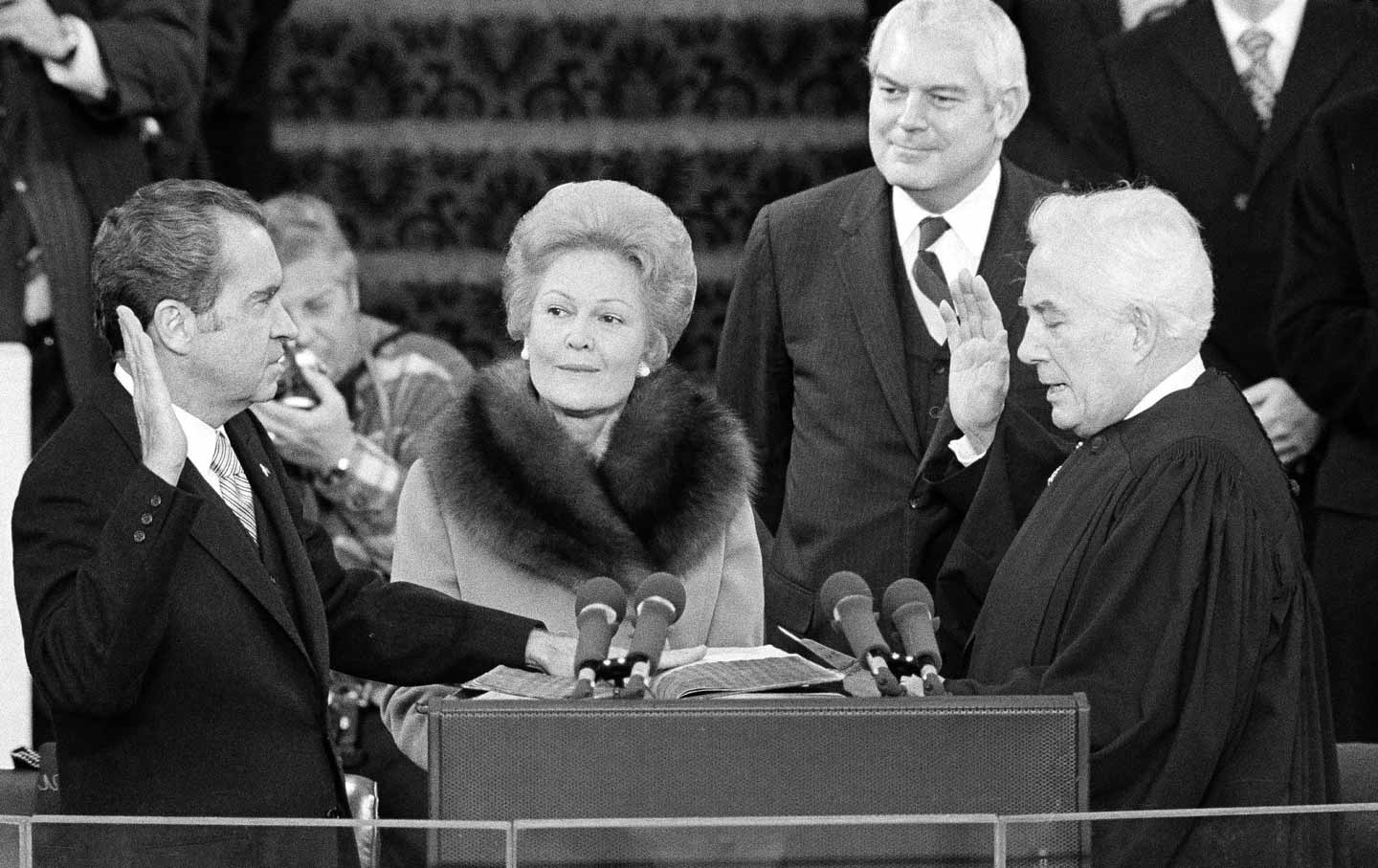 Burger, writing for the Court in two important cases, employed a literal or formalistic rather than a functional approach to separation of powers. In Immigration and Naturalization Service v. Chadha[xxix], the Court overturned more Congressional enactments than it had in its whole history. The case involved the legislative veto, a tool that had allowed Congress to delegate powers to administrative agencies while retaining power to veto specific administrative regulations. The Court held the legislative veto was unconstitutional because it did not include bicameral passage and presentment to the President required of all legislation.
Burger, writing for the Court in two important cases, employed a literal or formalistic rather than a functional approach to separation of powers. In Immigration and Naturalization Service v. Chadha[xxix], the Court overturned more Congressional enactments than it had in its whole history. The case involved the legislative veto, a tool that had allowed Congress to delegate powers to administrative agencies while retaining power to veto specific administrative regulations. The Court held the legislative veto was unconstitutional because it did not include bicameral passage and presentment to the President required of all legislation.
In Bowsher v. Synar[xxx], the Court struck down a key provision of the Balanced Budget and Emergency Deficit Control Act of 1984. The Act attempted to cut the annual budget deficits by a mechanism that at one point employed the Comptroller General, an officer of Congress removable only by joint resolution of both Houses. The Court held the law unconstitutional because it provided an impermissible delegation of executive power to a legislative official.
Burger wrote the leading case on the pardon power, Schick v. Reed.[xxxi] The case involved commutation of a death sentence. The pardon power, Burger wrote, “flows from the Constitution alone” and “it cannot be modified, abridged, or diminished by the Congress.” The pardon power is a Presidential prerogative, which, he wrote, ought not be fettered. Further, the President has the power to attach conditions to his commutation of any sentence.
Racial Civil Rights
Apart from the opinions of the Court involving desegregation of public schools (Swann v. Charlotte-Mecklenburg Board of Education; Milliken v. Bradley) discussed in the section on the work of the Burger Court, Chief Justice Burger wrote a number of less well known opinions involving racial civil rights.
In Palmore v. Sidoti[xxxii], a unanimous court struck down a state court decision denying a mother custody of her child because she had married a person of a different race and, as a result, the child might suffer prejudice. The Court stated that “the Constitution cannot control such prejudices, but neither can it tolerate them…The effects of racial prejudice, however real, cannot justify a racial classification removing an infant child from the custody of its natural mother, found to be the appropriate person to have such custody”.
In Bob Jones University v. United States[xxxiii], Burger wrote for the Court rejecting the argument of the Reagan Administration by holding that the Internal Revenue Service has the authority to deny tax exemptions to private schools, even schools run by religious organizations, if they discriminate on the basis of race.
Finally, the Chief Justice wrote for a unanimous court in what may be the most significant case in the development of employment discrimination law under Title VII of the 1964 Civil Rights Act.[xxxiv] The Court held that, while under the Constitution proof of discriminatory impact was not sufficient by itself to prove an Equal Protection violation, that under Title VII discriminatory impact could prove a violation of the statute without evidence of discriminatory purpose. Ostensible neutral practices were unlawful under Title VII, if they operated to maintain the effects of past discrimination.
Cases involving Church-State Relations
In one of his earliest opinions as Chief Justice, Walz v. United States[xxxv], Burger wrote upholding a state law which provided property tax-exemptions used exclusively for religious, educational or charitable purposes. The Court noted that the exemption for houses of worship fell within a broad class of property owned by nonprofit institutions including hospitals and libraries. Thus, the legislative purpose was not the advancement of religion, nor was it sponsorship of religion. Rather, the goal of the statute was to help nonprofit institutions that the government regarded as important to the community.
Lemon v. Kurtzman[xxxvi], a case involving state laws directly supporting the salaries of teachers of secular subjects in parochial and other nonpublic schools, proved to be the vehicle for what remains almost a half-century later the test for constitutionality under the Establishment Clause that is usually applied: (1) the statute must have a secular legislative purpose; (2) its principal or primary effect must be one that neither advances nor inhibits religion; (3) it must not foster an excessive government entanglement with religion. While the Lemon test has been criticized by various justices, it survives, although there have been a number of instances when the Court has decided Establishment Clause cases without employing it. In the Lemon case, the Court held the law unconstitutional.
Marsh v. Chambers [xxxvii] was an important Establishment Clause case in which Chief Justice Burger did not employ the Lemon test. In that case, the Court upheld the employment by the Nebraska Legislature of a minister to begin each session with a prayer. Upholding the practice, Burger relied upon the unambiguous and unbroken tradition of opening legislative sessions with prayers for 200 years. Burger pointed out that the same Congress that drafted the Establishment Clause had employed a chaplain.
In Wisconsin v. Yoder[xxxviii], Chief Justice Burger wrote for the Court, which held that the application of Wisconsin’s compulsory high school attendance law to members of the Conservative Amish Mennonite Church was unconstitutional. The Amish had argued that compulsory high school attendance might undermine their religious community; that it would gravely endanger, if not destroy, the religious beliefs of parents under the Free Exercise Clause of the First Amendment as well as their liberty interest to bring up their children as they chose.
Freedom of Speech and Press
The Burger Court generally expanded freedom of speech and freedom of the press rights. Warren Burger wrote an unusual number of those opinions.
Prior to Burger’s appointment, the Court had been plagued by cases involving arguably 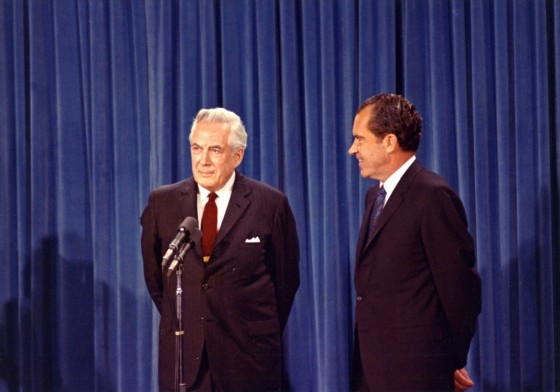 pornographic material, which it had been deciding on an ad hoc basis. In Miller v. California,[xxxix] and four related cases decided the same day, the Supreme Court reformulated the test for obscene matter unprotected by the First Amendment. Although on the surface somewhat more restrictive than the most recent test devised by the Warren Court, the test was more attuned to differing circumstances and communities and effectively ended the Supreme Court’s unhappy involvement as a “super-censor,” although it did little to stop the availability of pornography.
pornographic material, which it had been deciding on an ad hoc basis. In Miller v. California,[xxxix] and four related cases decided the same day, the Supreme Court reformulated the test for obscene matter unprotected by the First Amendment. Although on the surface somewhat more restrictive than the most recent test devised by the Warren Court, the test was more attuned to differing circumstances and communities and effectively ended the Supreme Court’s unhappy involvement as a “super-censor,” although it did little to stop the availability of pornography.
In Miami Herald Publishing Company v. Tornillo[xl], a unanimous Supreme Court held that a newspaper may not be compelled to print a reply of a political candidate whose character or record it had attacked.
In Nebraska Press Association v. Stuart[xli], the Court refused to hold all gag orders on the press by trial judges presiding over ‘sensational’ criminal cases unconstitutional, but it made ordering one extremely difficult by holding that a trial judge doing so would have to overcome the heavy presumption of constitutionality attaching to prior restraint on publication.
Wooley v. Maynard[xlii] was an unusual case involving a Jehovah’s Witness couple who considered the New Hampshire state motto, “Live Free or Die” repugnant to their moral, religious and political beliefs. The motto had been placed on all New Hampshire automobile license plates. The couple covered up the motto on their license plate and was prosecuted for doing so. The Court ruled for the Maynards, holding that a state may not constitutionally require an individual to participate in the dissemination of an ideological message by forcing that it be displayed on private property in a manner and for the express purpose that it be observed and read by the public. Writing for the Court, the Chief Justice emphasized that the First Amendment protects not only the right to speak freely, but also the right to refrain from speaking.
In Richmond Newspapers, Inc. v. Virginia[xliii], a unanimous Supreme Court held that the public and the press have a First Amendment right to attend criminal trials. In a case which generated six opinions, the Chief Justice, writing for a plurality, emphasized the long history of criminal trials at common law and their presumptive openness.
In Bethel Sch. Dist. No. 403 v. Fraser[xliv], the Court broke from precedents recognizing the rights of public school students and upheld the punishment of a student for a speech given at a school assembly filled with sexual innuendo. Burger’s opinion emphasized the need for judicial deference to educational institutions.
Burger and the Administration of Justice
The arena in which Warren Burger most distinguished himself as Chief Justice was judicial administration, where his energy and boldness made important contributions to both federal and state courts.
Change at best is slow in judicial administration. Few judges have the interest and the time to address the perennial problems of the courts – outmoded structures and laws and inefficiency breeding delay. Presidents and governors usually have what at least they consider to be more urgent items on their agenda, while legislators have few incentives to devote time to legislation aimed at improving the courts. Litigation before the federal courts had begun to explode around 1960. By 1969 that explosion and growing public frustration with aspects of the American court system pointed to the need to make clear to the public just how serious the problems were.
From the very beginning, Burger signaled his interest, energy and willingness to commit his time and the prestige of his office to modernize court management. He had said at his confirmation hearing that the Chief Justice “has a very large responsibility to try to see that the judicial system functions more efficiently” and that he “would expect to devote every energy and every moment of the rest of my life to that end should I be confirmed.” Burger’s agenda grew quickly to include assisting state courts, encouraging alternate dispute resolution as an alternative to litigation, raising the skills of trial lawyers and even prison reform. Although not all his initiatives bore fruit, only William Howard Taft among Chief Justices made as substantial a contribution to the administration of justice as Burger.
Early in his tenure, Burger was the catalyst for the creation of new institutions – an Institute of Court Management to train court administrators and a National Center for State Courts for studies of the efficacy of jurisdiction, structures and, new technology aimed at improving state justice systems. In the Chief Justice’s role as Chairman of the Board of the fledgling Federal Judicial Center, Burger strongly backed its studies and courses given for newly appointed judges.
Burger sought ways to encourage the law-making and law-executing branches to focus on the needs of the courts. He became the central spokesman for the federal courts, issuing an annual statement on the judiciary, speaking at meetings of the American Bar Association and American Law Institute and making himself visible for interviews. The Administrative Assistant to the Chief Justice (an office created at Burger’s request), Mark W. Cannon, came up with the idea for annual meetings of the leaders of the three branches concerned with issues of the administration as justice. These meetings in Williamsburg helped to break down extra-constitutional barriers between the branches.
Burger was a central figure in creating reforms that bred efficiency and was a strong booster of others. Among them were professionally-trained circuit and district executives, managerial officers to aid the chief judges of the Courts of Appeals and larger district courts; the growing use of U.S. Magistrates to take over some of the work of district judges and continuing education for judges. He was a strong supporter of the use of alternatives to litigation, such as arbitration and mediation, and supported experiments of court-annexed arbitration in the federal courts.
As already suggested, under Burger, the friction between state and federal courts diminished considerably. While some of this can be attributed to growing acceptance of the Supreme Court’s decisions in racial civil rights and the Supreme Court’s movement away from the Warren Court’s criminal procedure decisions, some was also the result of Burger’s concern for the needs of state courts and his deep belief in comity between federal and state courts. Comity was also assisted by Burger’s recommendation to the Conference of [State] Chief Justices for state-federal judicial councils in each state to maintain communication on all problems shared by the court systems. Such councils would be established in many states.
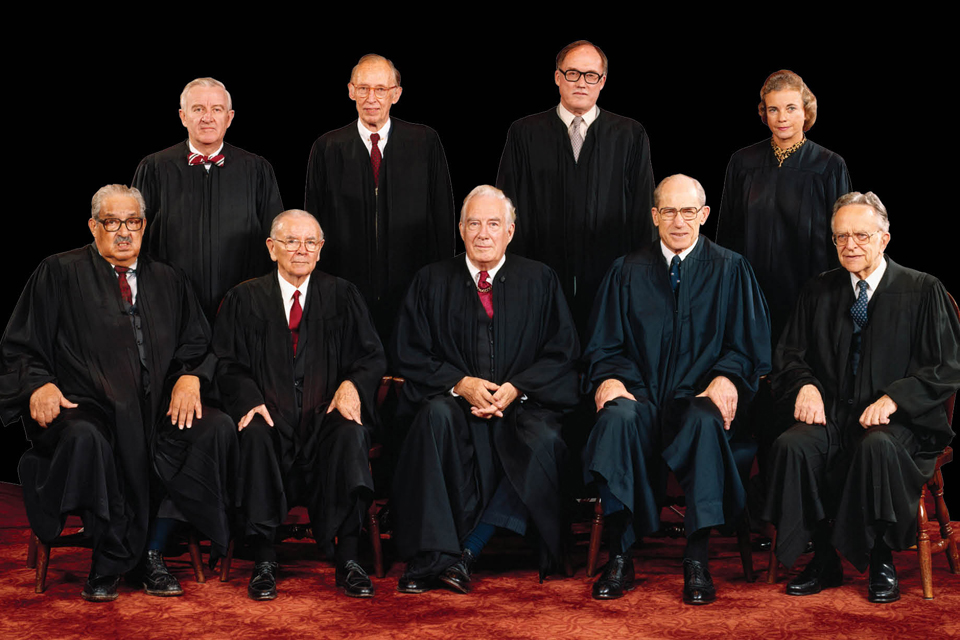 Not all of Burger’s recommendations bore fruit. His attempt to improve the level of advocacy in trial courts drew more attention than acceptance. His strong support for reform in the treatment of prisoners made little or no headway. Yet, on the whole, Burger left a significant mark. He brought visibility and energy to an area which had been a backwater. He was successful in building coalitions to support change. After his retirement as Chief Justice, allies on the bench, in the bar and in the political branches continued to build on many ideas and structures to which Burger had given attention during his Chief Justiceship.
Not all of Burger’s recommendations bore fruit. His attempt to improve the level of advocacy in trial courts drew more attention than acceptance. His strong support for reform in the treatment of prisoners made little or no headway. Yet, on the whole, Burger left a significant mark. He brought visibility and energy to an area which had been a backwater. He was successful in building coalitions to support change. After his retirement as Chief Justice, allies on the bench, in the bar and in the political branches continued to build on many ideas and structures to which Burger had given attention during his Chief Justiceship.
Conclusions
Warren Burger served seventeen years at Chief Justice. “His” Court was a transitional court, pragmatic and flexible, consolidating Warren Court jurisprudence in some areas, turning away from it in others and creating some new law on its own. As Chief Justice, Burger was not the intellectual leader of his court, if, indeed, his court had such a leader. While nobody can gainsay the enormous energy and commitment Burger brought to his office, arguably he might have spread himself too thin to have been at his most effective in attempting to lead the Supreme Court. Part of Burger’s legacy can, of course, be seen in his opinions. This paper suggests that in areas such as First Amendment speech, press and religion, racial civil rights and separation of powers, those opinions and others have so far survived the test of time. Burger also made an important contribution to federal and state judicial administration by helping to create important new institutions and spurring innovations that aided efficiency.
Finally, it should be noted that during Warren Burger’s seventeen years as Chief Justice, as contrasted with other periods of Supreme Court history, the Court was not under bitter political attack. It was unhampered (except in one short case) by superannuated justices and free (at least after the resignation of Justice Fortas) of accusations of corruption and of distracting feuds and serious internal tension. During the greatest test the Burger Court faced – the Nixon Tapes Case – it lived up to its constitutional role. The Court’s prestige would be greater when Burger left it in 1986 than it had been when he came in 1969.
[1] Justice William O. Douglas was replaced in 1975 by John Paul Stevens. Justice Potter Stewart was replaced in 1981 by Justice Sandra Day O’Connor. The effect of these appointments, put loosely, was to make the Court a little more conservative.
[2] When analyzing government action under the Equal Protection Class, if the party affected belongs to a suspect class (race, religion, national origin, alienage), strict scrutiny is employed – the government must demonstrate that it has a compelling interest for its action and must have narrowly tailored the law to achieve that interest.
END NOTES
i. Warren E. Burger, “What to do about Crime in U.S.: A Federal Judge Speaks,” U.S. News & World Report, Aug. 7, 1967, p. 70ff.
ii. See E.W. Kentworthy, “Burger Nomination is Lauded by Conservative Members of Senate Judiciary Panel”, N.Y.Times, May 22, 1969, p. A26; “The Appointment of Warren Earl Burger”, Washington Post, May 23, 1969, p. A26 (editorial); Philip Kurland quoted in “A Professional for the High Court,” N.Y. Times, May 30, 1969, p. A16.
iii. See Sidney E. Zion, “Nixon’s Nominee for the Post of Chief Justice: Warren Earl Burger,” N.Y.Times, May 22, 1969, p. 36.
iv. United States v. Richardson, 418 U.S. 166 (1974).
v. Sierra Club v. Morton, 405 U.S. 727 (1972).
vi. Simon v. Eastern Kentucky Welfare Rights Org., 426 U.S. 26 (1976)
vii. Eisen v. Carlisle & Jacqueline, 417 U.S. 156 (1974).
viii. 411 U.S. 1 (1973).
ix. 457 U.S. 202 (1982).
x. 473 U.S. 432 (1985).
xi. Younger v. Harris, 401 U.S. 37 (1971).
xii. Stone v. Powell, 428 U.S. 465 (1976).
xiii. United States v. Leon, 468 U.S. 897 (1984).
xiv. 384 U.S. 436 (1966).
xv. See, e.g., Harris v. New York, 401 U.S. 222 (1971).
xvi. 372 U.S. 335 (1963).
xvii. Argersinger v. Hamlin, 407 U.S. 25 (1972).
xviii. Swann v, Charlotte-Mecklenburg Board of Education, 402 U.S. 1 (1971).
xix. Keyes v. School District 1, Denver, 413 U.S. 189 (1973).
xx. Milliken v. Bradley, 418 U.S. 717 (1974).
xxi. 438 U,S, 265 (1978).
xxii. Reed v. Reed, 404 U.S. 71 (1971).
xxiii. Frontiero v. Richardson, 411 U.S. 677 (1973).
xxiv. Craig v. Boren, 429 U.S. 190 (1976).
xxv. 410 U.S. 113 (1973).
xxvi. See Akron v. Akron Center for Reproductive Health, 462 U.S. 416 (1983).
xxvii. Thornburgh v. American College of Obstetricians & Gynecologists, 476 U.S. 747 (1986).
xxviii. 418 U.S. 683 (1974).
xxix. 462 U.S. 919 (1983).
xxx 478 U.S. 44 (1986).
xxxi. 419 U.S. 256 (1974).
xxxii. 466 U.S. 429 (1984).
xxxiii 461 U.S. 574 (1983).
xxxiv. Griggs v. Duke Power Co., 401 U.S. 424 (1971).
xxxv. 397 U.S. 664 (1970).
xxxvi 403 U.S. 602 (1971).
xxxvii 463 U.S. 783 (1983).
xxxviii 406 U.S. 205 (1972).
xxxix 413 U.S. 15 (1973).
xl 418 U.S. 241 (1974).
xli 427 U.S. 539 (1976).
xlii 430 U.S. 705 (1977).
xliii 448 U.S. 555 (1980).
xliv 478 U.S. 675 (1986).
